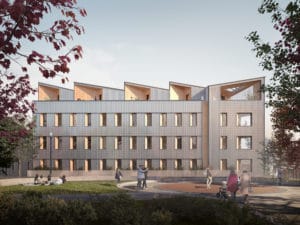
Placetailor’s 201 Hampden in Roxbury will be the first fully cross-laminated-timber-built development in Boston. Image courtesy of Placetailor
The greatest innovation in housing is not any specific material, system or assembly. It’s the rapidly growing movement to continually define and consistently deliver future housing.
Future Housing is a theme, and an ideal. It serves as a compass for the myriad facets of the housing industry. It’s a call to developers, designers, builders and communities to demand better and do better. Future Housing is architectural activism.
There are four distinct crises related to housing that are not unique to Boston, but are exaggerated in this old, coastal, segregated city of ours. There is a climate crisis, which threatens our low-lying areas, and demands that housing play its part in reducing energy use and carbon emissions. There is a housing crisis – in that we do not have enough of it, aren’t building it fast enough, and therefore see continual cost increases. There is a community crisis, where underserved communities of color are being too rapidly gentrified, displacing long-time residents and tearing the social fabric. And there is a health crisis, with some buildings containing toxic materials or otherwise providing poor-quality air to residents.
All of these are distinct issues, yet all are interrelated, so that if in the production of housing we are not simultaneously addressing all four crises, we are inadvertently making the others worse.
Break Down Entrenched Thinking
Future Housing facilitates a zero–carbon lifestyle, in both embodied and operations energy use. It’s accessible to varied income levels, including a vanishing middle class, in part through density. It isn’t economically “extractive,” providing avenues for home ownership and for progressive local equity investment models. It uses healthy materials and gives constant fresh and filtered air to families. Future Housing asks what wrongs need righting and finds a way to make it so.
Rest assured, it ain’t easy – at least not within the current architecture, engineering and construction industry. Anyone who’s been deep into the sustainability world for the last couple of decades will tell you how outdated assumptions, business-as-usual momentums and entrenched thinking kill innovation. The typical delivery process is a zero-sum game, adversarial and litigious. These models drive everything. If the mission is profit, through the safe delivery of a standard product for a standard industry-accepted margin, then your goal is to rinse and repeat. If the delivery model hasn’t found a way for a strong mission to be profitable, then you won’t get Future Housing.
Placetailor is an example of an organization whose mission to deliver sustainable housing drove our business model to evolve past the typical hurdles. Placetailor is a cooperative of four divisions: development, design, build and technologies. The vertically integrated business model has allowed us to create exclusively Passive House and zero-carbon buildings serving local communities for the past 12 years.
Lessons We Learned
One critical lesson we learned is that in our integrated model, innovations don’t get killed by only one part of a development team not making its standard margin. Profits can be made, or lost, flexibly across the entire chain, making it possible to draw that line in the sand.
Another lesson is that when including design and/or build scopes, it has becomes feasible for us to develop for local clients who wouldn’t otherwise know who to call.
Lastly, we think others can learn a lesson from the positive feedback loop we’ve created from our commitment to our mission. When adhering to Future Housing ideals, community process and variance approvals are swifter, and on the back end the demand for value-aligned product, when sold at full market rate, has yielded considerably greater returns.
So, the arguments about whether or not to go Passive House or zero net energy (ZNE) because of the 0-2 percent initial cost increase are meaningless when market–rate units sell for an average of 13 percent above comps.

Colin Booth
Join Us
There is momentum in the movement, and promise in this new model.
Placetailor’s design studio has recently merged with Elton Hampton Architects, whose affordable housing work in Boston will now have to adhere to the city Department of Neighborhood Development’s new zero emission building standards – standards that were developed by Placetailor. The integrated process is now being refined and optimized by our new Operations Director Bradford Prestbo, a master of project delivery and a former technical director at Sasaki.
Katie Faulkner has joined as the director of technologies, contributing experience in design excellence from her days running the NADAAA studio, as well as perspectives in delivery process and tech from her time as vice president of design at Katerra.
The future of housing is a reflection of the future of the industry. Like all things, now, it’s a vehicle for impact, a call to action. Join us. Occupy the future.
Colin Booth is strategic director of Boston-based Placetailor.




 |
| 
